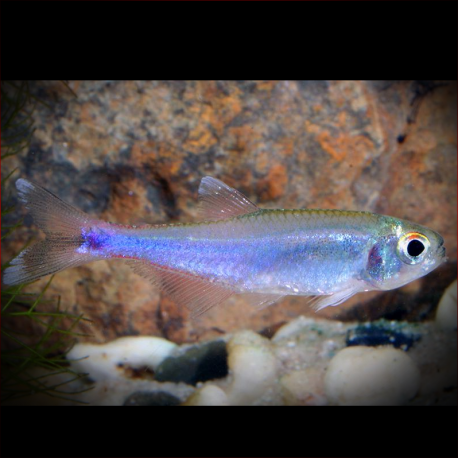More info
Datasheet
| Minimum Tank Size | 90 litres / 23.78 US gallons |
| Maximum Size | 5.0cm / 1.97inches |
| Temperature | 22°C / 71.60°F - 26°C / 78.80°F |
| Hardness | 5-12ºdH |
| pH | 5.5-7.0 |
General Description
The Blue Tetra, also known as Knodus Borki, is recognized for its intense coloration, often mistaken as artificially enhanced due to its vibrancy. Belonging to the Characidae family, it is the sole species within its genus. Native to Colombia and Brazil, this tetra species can reach up to 5.0cm in size and thrives in rivers, streams, and tributaries.
Aquarium Setup
For optimal care, these tetras thrive in a heavily planted tank with dark substrate and floating plants that help diffuse lighting, enhancing their colors. To prevent aggression, maintain at least 8-10 specimens in a spacious aquarium of a minimum size of 90 litres. A well-maintained habitat may include sand substrate, twisted beech branches, roots, dried leaves, and an addition of aquarium-safe peat or peat moss to the filter for a natural, stained water appearance.
Behaviour
While generally peaceful, the Blue Tetra may exhibit fin-nipping behavior towards conspecifics and fish with elongated fins, especially during feeding or in cramped conditions. To deter aggression, it is recommended to keep them in a larger group and avoid pairing them with slow-moving tankmates. They are not suitable as dither species for dwarf cichlids but can coexist with other tetras, Loricariids, and smaller catfish species like Corydoras sp.
Feeding and Diet
Being omnivorous, Blue Tetras accept a variety of foods with a preference for small live and frozen foods such as bloodworms, daphnia, and brine shrimp. Including vegetable matter like blanched spinach or high-quality Spirulina flakes in their diet is essential for their nutrition.
Reproduction & Dimorphism
Reproduction of Blue Tetras requires a separate spawning tank without substrate but with broad-leaved plants like Amazon swords for egg laying. Males exhibit more intense coloring and develop reddish anal fins during spawning. Conditioning the breeding pair with high-quality live and frozen foods is essential, while the fry need infusoria or Paramecium as their initial food source.
Habitat and Distribution
In their natural habitat of Colombia and Brazil, Blue Tetras inhabit rivers, streams, and tributaries with water conditions of a hardness of 5-12 dH, pH of 5.5-7.0, and a temperature range of 22-26°C. Maintaining dissolved oxygen in the water is crucial for their well-being.

